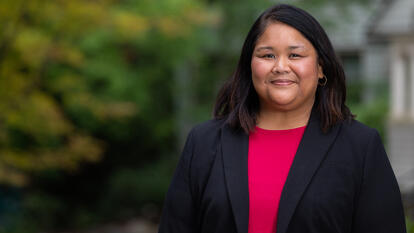Wellesley Students Demonstrate Maker Capabilities at the World Maker Faire

As the concept of the maker culture—where people use 3-D printers, 3-D scanners, and other technology to create physical objects from their own designs—becomes increasingly familiar, many in higher education are asking, “How can this enhance the educational experience for our students? And how can it benefit society?”
Four Wellesley students—Aubrey Simonson ’19, Anna M. Pfoertsch ’18, Michelle Lu ’18, and Kamile Lukosiute ’19—provided answers to those questions at the annual World Maker Faire in New York City in early October. In collaboration with students and faculty from Brandeis University, Colgate University, Olin College, and the University of Connecticut, they designed and hosted an exhibition booth that won an Editors’ Choice award from Make: magazine, which organizes Maker Faires around the world.
Jordan Tynes, manager of scholarly innovations at Wellesley, accompanied the Wellesley students, who brought several kinds of 3-D printers, explanatory posters, a robotic vacuum cleaner that had been modified to draw on paper, and a “mountain” of 3-D printed objects, he said, including shoes, knickknacks, a medieval tower, and a replica of moon craters.
Attendees of all ages, from toddlers to seniors, asked to see how the printers operate and enjoyed handling the variety of objects on display.
“The most profound interaction I had was with someone who was blind. He was able to ‘see’ a medieval tower by holding ours in his hands, and he felt a map of Rio de Janeiro, where he was born,” Tynes said.
Visitors also asked how the maker movement might benefit hobbyists, K-12 students, grandparents, and people who aren’t comfortable using technology.
The Wellesley students had answers at the ready—all are Knapp Interns who are used to assisting people who come to the Knapp Media and Technology Center in Margaret Clapp Library to work on various projects, said Tynes.
Michelle Lu ’18, a Knapp intern since her sophomore year, emphasized how 3-D printing can be useful in many fields, including archaeology, as she learned last summer when she used maker tools to document an archaeological dig in Greece, which was directed by Bryan Burns, associate professor of classical studies.
“At the end of every day, we would fly drones and take photos of the trenches, so that the trench supervisors could look at them and make decisions about where to dig (or make deeper) next,” Lu said. “We also used drones to make a 3-D model of the entire dig site, which people could then experience with a virtual reality headset, so they felt that they were transported to the dig site.”
In addition to winning the Make: Editors’ Choice award, the team of Wellesley and cohorts spoke at a panel discussion hosted by the magazine. One important recurring point, said Tynes, was that maker cultures must evolve to meet the needs of each specific campus.
For example, Brandeis has a centralized maker space, with more than 50 3-D printers and other tools in one room, while at Wellesley maker tools are available in several places, including the Human Computer Interaction (HCI) Laboratory, Media Arts Lab, Engineering Lab, Clapp Library, and the Book Arts Lab. That model allows different groups to think about how they can collaborate on projects and find solutions to problems, as when students in a History of the Book class wanted to create a replica of a wood block that had been used to print a page in a book from 1514 in Wellesley’s special collections. The students photographed the page and tried to create a 3-D copy, but the copy did not create a print that looked like the original. The class contacted the Engineering Lab, which used a laser cutter to produce a digital image of a woodcut, and then took that image to the machine shop, which created a very accurate wood block, Tynes said.
After the Maker Faire, the question “where do we go from here?” was also explored at Wellesley during “Making and Fabrication for the Liberal Arts,” a panel and showcase on October 13. Staff and faculty from several departments discussed the ways various departments are using emerging technology to meet the needs of current students, and how they can prepare for future students, many of whom are being introduced to 3-D printers and scanners, and even drones, in elementary school.
“The consensus seemed to be that the answers will be different for different types of institutions, so it’s important to be sensitive to the culture on your campus,” said Tynes. “We also need to make sure that we don’t try to tell people how to use this technology, but instead give them the skills they need so they can tell us how the technology can be used for them. It’s exciting for people to suddenly realize that they have agency in the way the world is designed and comes up physically around them.”



